There is an important hurdle all crime scene investigators, law enforcement personnel, laboratory technicians and many others must overcome in the discovery of material in a forensic investigation.
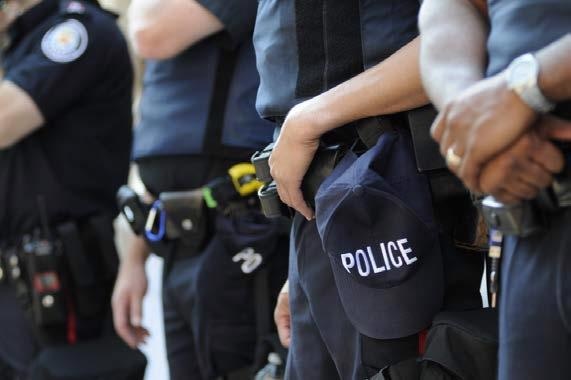
Illicit drugs chemical precursors, hair strands and gun powder residue are examples of some of the things that technicians have to examine on a daily basis during an investigation.
Previously, numerous types of identification were required to be able to gather results from different types of forensic samples. Specific devices can be used for accurate laboratory identification, however Raman spectroscopy, as well as other technologies, can achieve successful identification of a variety of forensic sample types either in laboratory conditions or out in the field.
Raman spectroscopy is an example of a Category A analytical technique protocol by the Scientific Working Group for the Analysis of Seized Drugs (SWGDRUG; Version 7.1, 2016).
Raman Spectroscopy Overview
Raman spectroscopy is a well-known, extremely precise analytical technique that can be carried out to evaluate slurries, solids and aqueous compounds. Vibrational spectroscopy is a method that utilizes its sensitivity to vibrations of atoms in molecules, and then this information is used to name the compound, Raman uses this technique also.
Infrared (IR) spectroscopy also used this method of vibration sensitivity and so, IR and Raman are popular forensic methods in laboratories that have been used for many years. Their popularity and long-standing use throughout time is a result of their low false positive rates and high specificity.
As a consequence of Raman spectroscopy being specific to the chemical structure of a sample, it will not destroy the sample when trying to identify it. This is a huge advantage when comparing it to other analytical techniques. Narcotics are an example of organically-based chemical compounds and contain molecules that vibrate at different frequencies and can be differentiated from one another.
The amount and wavelength of a molecules vibration is reliant mainly on the amount of atoms contained within the chemical compound and in what way they interact through types of chemical bonds. Using the information we know about what amount and frequency of vibrations will be present when certain bonds and number of atoms are present in a specific compound, analysis of the vibrations can be used to identify the compound in a sample. For example, the graph below shows the spectroscopy of the narcotics methamphetamine and cocaine, from which they can be clearly differentiated from one another.
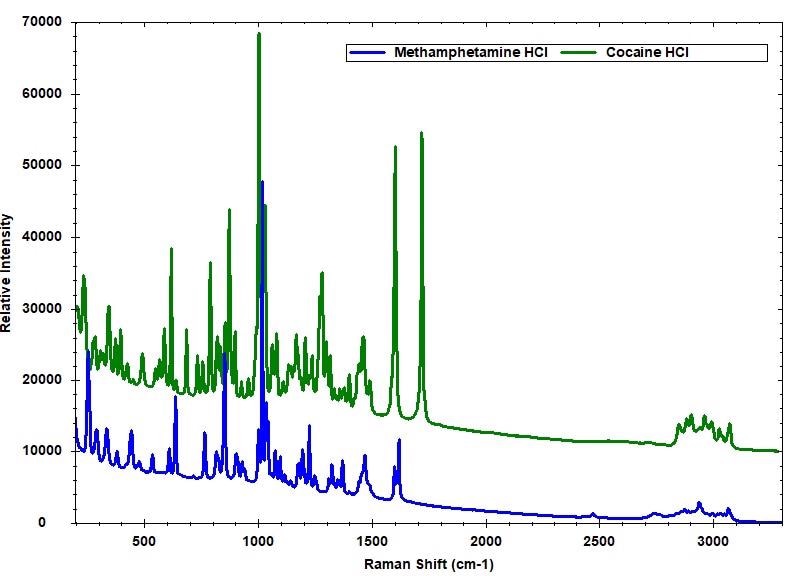
This type of graphical illustration is used by Raman spectroscopy to identify different compounds using their individual vibrational frequencies. It is taken and produced from experimental measurements of the compound’s vibrational frequencies and presented graphically for the user to interpret.
The spectrum of the scattered Raman signal is created from a sample by operating a laser incident onto it in Raman spectrometers. The typical laser used for Raman is the 785 nm excitation system because it presents the optimal sensitivity to fluorescence, balance of signal, overall function and cost, as well as being able to gather the Raman spectrum of the majority of organic compounds rapidly.
A laser excitation system of 1064 nm is used in Raman spectroscopy when analyzing samples that are very pigmented or dark in color and so require a longer excitation wavelength for better results.
Raman spectrometers can also come in portable and handheld sizes to give evaluation options for in the field applications and quick screening, as well as thorough analysis of samples in a controlled laboratory setting. There are also a variety of laser excitation options that allow for the best-suited system to evaluate different sample types.
TacticID® Handheld Raman System
Perfect for testing batches of explosives, hazardous compounds, illicit drugs, cutting agent, precursors, and therapeutic compounds, etc. the TacticID is a handheld device specifically for field-based applications, which can return results in seconds.
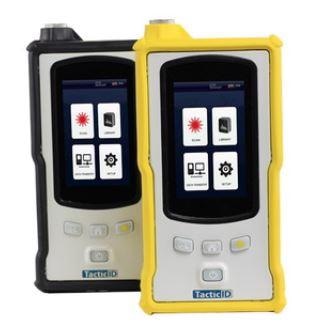
Utilizing Raman spectroscopy, the TacticID gives the extreme chemical precision of Raman, as well as non-contact and sample preservation analysis. This has the benefit of reducing the contact that law enforcement officers have with unknown compounds, whilst avoiding altering the condition of the evidence.
The majority of illicit drug compounds can be identified rapidly and in the container they were found, the method requires simply pressing the unknown material within a package, for example a plastic bag, to the analyzer sampling probe and pushing the scan button.
Interpretation of the results are not required by the use, the TacticID gives a concise and final result, as well as storing all sample results automatically with a date and time. The TacticID also has a mixture analysis option, which is especially important because samples are rarely a single pure substance, and this setting allows the different components of the mixture to be identified.
The user-friendly interface of the device enables simple movement of stored data from the TacticID to a computer for secure, automated data reporting and storage. The results can be used to support chain of custody for prosecution with printable, permanent records and a diagnostic self-check program that ensures that the device is operating accurately at the time of use.
When identifying small amounts of a compound in a sample, surface-enhanced Raman spectroscopy (SERS) can be used to intensify the signal of the tested substance, to improve detection. In order to carry out this technique, the sample must be dissolved in a solvent and then it can be applied to the SERS substrate.
The TacticID, with the addition of a specialized TacPac™ adapter can then directly measure the SERS sample. This type of low-level substance identification is particularly valuable for applications in detecting counterfeits.
i-Raman® EX 1064 nm Fiber Optic Portable Raman System
The i-Raman EX portable Raman system perfect for applications such as petroleum analysis, biomedical diagnostics, food/agriculture and explosive detection, as well as forensic analysis, including illicit drugs, therapeutic compound analysis, biological samples and natural compounds, particularly those that may be dark or highly pigmented.
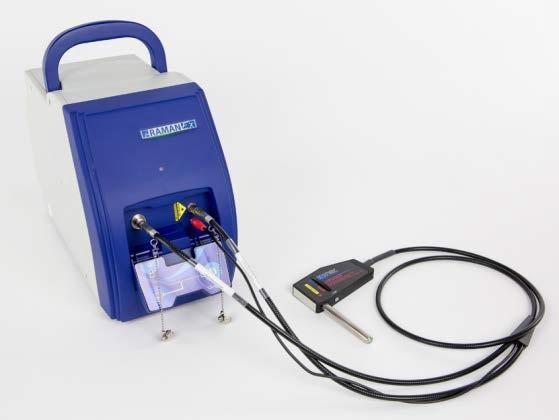
The i-Raman EX has a high sensitivity InGaAs array detector with deepTE cooling and high dynamic range, as well using a 1064 nm excitation laser. The device has a high signal-to-noise ratio but does not induce autofluorescence.
The operator has complete flexibility when choosing measurement parameters, and has access to a library that can be used to identify compounds against or developing quantitative analysis methods. When measuring slurries, fibers, solids or liquids, the fiber-optically coupled system can be used. High accuracy of qualitative and quantitative forensic solutions can be achieved by the i-Raman EX.
The Raman video microscope can be paired with the i-Raman EX for micro sampling and accuracy of testing on a particular part of a sample. Forensic applications have the greatest level of flexibility in Raman sampling when using the microscope accessory. The camera built into the microscope enables accurate Raman sampling via camera monitoring of the laser beam and imaging details.
When paired with the i-Raman EX, it has the benefits of the Raman microscope but at a tiny proportion of the expense of other research equipment.
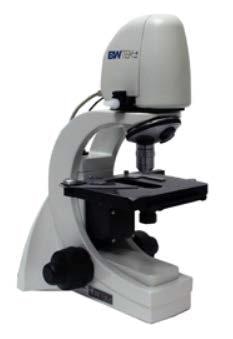
i-Raman EX and TacticID-1064 for Heroin Identification
Globally, the narcotic heroin poses cause for concern and is increasing in use in some populations. Typically, a 785 nm laser wavelength is used in the Raman device, however it normally struggles to differentiate common street heroin, as well as other dark samples. This is as a result of the naturally high impurities and fluorescence due to being cut many times.

If a longer wavelength is used, such as 1064 nm, like in the i-Raman EX, there is no issue of fluorescence when looking at samples that contain heroin, graphically represented above. This makes the i-Raman EX and the TacticID-1064 perfect for extremely precise differentiation of heroin and other street samples.
Conclusion
The capability to analyze and identify a huge range of compounds typically found in forensic science is provided with B&W Tek. Taking advantage of this selection of forensic equipment, users can carry out reliable and tried techniques for forensic analysis at any location, increasing work rate with no compromise to the standard of the instrument of analysis.

This information has been sourced, reviewed and adapted from materials provided by B&W Tek.
For more information on this source, please visit B&W Tek.